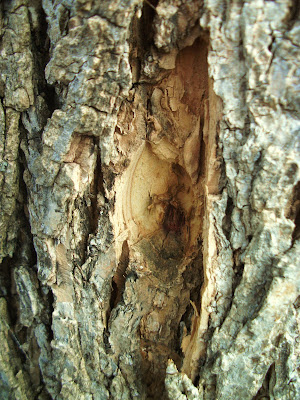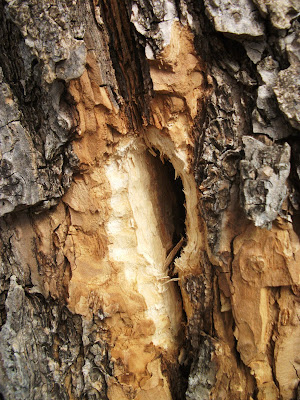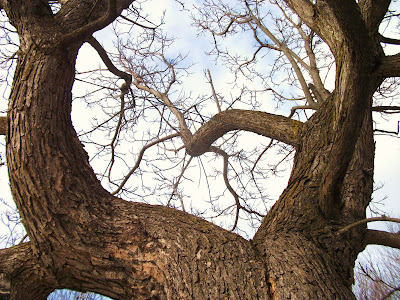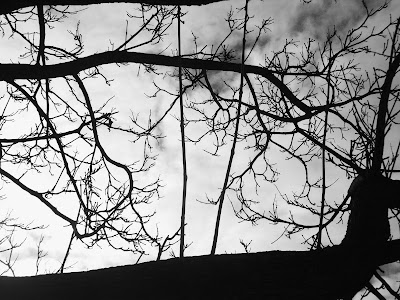
I spent some time with my
Tree Year trees last weekend. The balsam poplar is loaded with buds, which will soon turn into pretty little catkins. I'll post about that another day. But today let's take a look at the catalpa tree I'm observing for the year.

As you can see, not much is going on here. Nary a bud in site. While plenty of other trees put out buds in late winter through early spring, the catalpa is truly a late bloomer in this department. But once she does finally leaf out, she'll be the prettiest tree in the park. I'm excited to watch for the first signs of this!

In my
last post I expressed some concern about the splits and cracks I noticed in the bark. I went to see
Diana Beresford-Kroeger give a talk recently and afterwards I asked her if she had any insight into what might be going on. She said that it was a common problem with catalpas and had noticed it on her trees. She thinks it's a fungus that weakens the bark and then it splits. The good news is, she doesn't think it does any long-term, or life threatening damage to the trees and they seem to recover and thrive well enough. Phew. That's a relief. And from the looks of things, this tree seems to be recuperating. The exposed inner bark is no longer raw looking.

However it appears that some creature has decided to take advantage of the openings. There are two construction sites going on. Something trying to carve out a home perhaps?

I have no idea what creature might be at work here. The two sites are about four feet up the trunk. The second site has a gnawed on look which makes me think it might be a squirrel as opposed to a bird. Any naturalists or wildlife experts out there who might have some thoughts on this?

Well, it won't be the first time this tree has had some mod work done on it. Do you see the wire cable anchored into the trunks up there? My guess is the city was worried those two trunks might break and split apart, so they took preventive measures here. My mom has catalpas in her yard and over the years the upper trunks do tend to break off.

This large branch has four
water sprouts growing out of it. I wonder if that's a stress response from the splitting and gnawing? Water sprouts are undesirable on a tree, and not just for aesthetic reasons. The are more susceptible to pests and disease and weaken the tree. I'm thinking of maybe pruning them myself.

Finally, I just had to include this pic of some of the bark. I love the texture and lines of it.

Stay tuned for more tree year posts!
Update: Uh, I guess I should make an effort to get my
tree anatomy correct and learn the difference between a trunk and a branch. I don't think this tree has 'two trunks' rather it has a forked trunk. And when I referred to the 'upper trunks' of my mom's catalpa trees, I actually meant large branches. I think.
2 comments:
I consulted a professional who does some great volunteer work (wrt trees) here in the city.
Her response is below:
======
I think your friend is right (but I could put up an infrared camera and do a wildlife study to be sure for a mere $1,000). Perhaps it is being chewed for new squirrel condos, or possibly to eat the cambium (the tissue growing under the corky outer layer). I don’t think the catalpa has especially sweet sap, but perhaps the squirrels think otherwise.
As the sap starts to flow, red squirrels sometimes chew holes in the bark of sugar maples and other hardwoods. After the sap oozes out and evaporation concentrates the sugar, the squirrels return to lap up the sweetness.
Your friend could put wire mesh hardware cloth or chicken wire around the trunk of the tree to prevent the chewing, and give the tree a chance to partition I off. Spraying the trunk with a taste repellent also might work (but it may wash off). Hot-pepper sprays and products such as Ro-pel are easy to use (so I’m told – I have personally never used them).
=====
Unstuffed - I vote for the Hot-pepper option, and perhaps add some bright mexican decorations too -- a spring Fiesta for saving sap!
J.G.!!! You're awesome. Thanks for this info dude. And please send my thanks to your source. :)
Now as much as I'd like to get all Hinterland Who's Who on the culprit, I'll probably skip the infrared camera set up and see what I can discover with patience and binoculars- though this is most likely a nocturnal operation!
However I think I will concoct some creature bane and paste it on as a deterent. I have a feeling this little catalpa has put up with a lot recently and could do with a break. Love the idea of the festive decorations too.
Oh and I did a little more research yesterday and learned that cabling a tree is common practice with forked trunks, but not without risks, and you really need to know what you're doing.
Learnening is fun!
Post a Comment